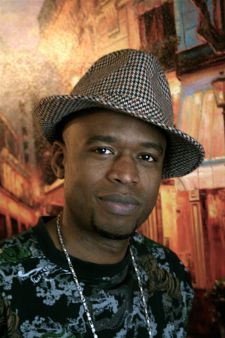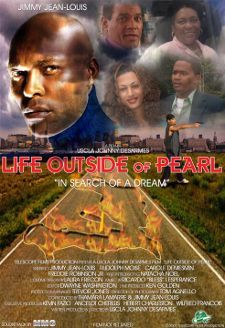
Uscla "Johnny" Desarmes
He's been called the Haitian American Spike Lee, and his new film looks set to make waves. We caught up with Uscla 'Johnny' Desarmes and asked him to give us the low down on Life Outside Of Pearl.
“Life Outside Of Pearl is a snapshot of Haiti – a world that’s hidden unto itself. It tells the story of a Haitian-American family and their struggles to keep their culture and their ethnic identity intact, living in America. In the news, we always see Haiti as this really poor country. I wanted to bring another slice of life to the big screen. The world needs to see Haiti in new light,” says Desarmes.
“I wanted to make this film because artistically, it’s a form of expression of humanity from a Haitian perspective. It took me five years to make this film, and it was a labor of love.”
The film explores a small community through the individual stories of its members. We asked Desarmes if any of his characters were based on real people.
“To tell stories about life, you have to live and absorb life,” he says. “I come from a family of storytellers that pass down stories from one generation to the next. Also, as a filmmaker, I’m always watching my surroundings and absorbing what I see. In the film, I tried to capture what I imagine life in Haiti to be.”
“My characters were based on people who have moved in and out of my life. No one person represents a particular character; however, the characters are blended personalities of people I know.”
So how do the culture clashes portrayed in the film reflect his own experience of moving to America ?
“I moved to the United States when I was a teenager, and it was a culture shock to me: the language, the culture, the people, even the weather was really different from my home in Haiti. But I had to make the transition to survive. I also had to deal with society’s view of the black man in America. That’s why I could authentically show the culture clashes in the movie, because I personally lived through it,” he explains.
And does he feel that having a better understanding of Haitian history can help to give Haitian Americans the confidence they need to assert themselves in their adopted country?
“Oh absolutely, first of all, Haiti was the first black republic that fought for freedom and won. And for Haitians, that gives us a great sense of pride, but still, we have a big history to live up to.”
“But, even in our adoptive country, America, we have a lot in common with people from the African Diaspora. Because of this, Haitians should feel like they’re part of a bigger family, and that they’re not alone in their struggle to live out the dream, the American dream.”
That dream doesn't seem to be working out for everybody. Some of the female characters in this film suffer significant ill-treatment at the hands of their male family members. We asked if he thinks this reflects an aspect of traditional culture that needs to change, or shows a distortion of traditional values. Did he face resistance from the community for looking at negative issues like this?
“Oh no, subject matters like incest, molestation, adultery – basically, women suffering at the hands of men – is not a Haitian problem, it’s not a culture problem, but it is a universal problem that crosses all boundaries of race, socio-economic backgrounds ... “ he says.
“By telling and pointing out the truth about something, it’s the only way to fix it. Yes, these topics are uncomfortable to discuss, but we must sometimes hold up a mirror to our own ugliness. That’s how we can make that change. That’s how we can make things better.”
Is this is a film that members of other immigrant populations will feel they can identify with? Is it a story that has wider resonance when it comes to the clash between young people and their more traditional older relatives?

“This film is for the entire family – whether you’re young or old, it will speak to you. I hate the way they segregate and market films based on demographics. The entertainment value of any film should be open to all people. I feel Life Outside Of Pearl is a Haitian story that anyone – whether, they’re black, white, Latino, young, old – can enjoy. I wanted to put out a film that resonates with all audiences,” he says.
Desarmes is also keen to give something back to the community, and has been donating some of the profits from the film to charity, as he explains.
“My company, Telescope Films, donated $10,000 to the Helping Hands Haitian Relief Effort in Miami, to help people suffering in Haiti from hunger. I really need the public to embrace this film for the philanthropic push to assist Haiti’s relief efforts. Part of the proceeds from the sale of film will go to the "500,000 United We Stand" campaign. I’m trying to raise $500,000 for Haiti because I want to do something good for my country. Right now, Haiti has its challenges, and I want to help uplift it.”
So will Desarmes' future projects focus on related issues?
“Yes,” he says. “I’m starting production on my next film, Baton. It’s a martial arts film that addresses the issue of integrity. Think about it: How much better could the world be if we were 100% fair with each other?”
Life Outside Of Pearl can be purchased on DVD online at MySpace.com/500000UNITEDWESTAND and www.UnitedWayStore.com.





















